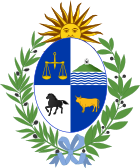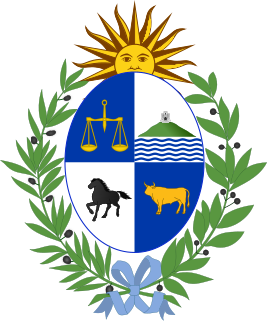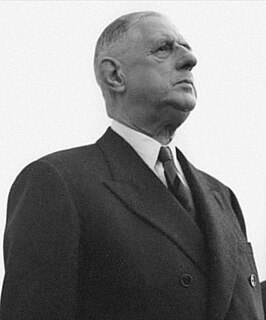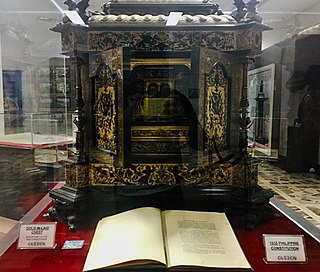 |
|---|
The third Constitution of Uruguay was in force between 1934 and 1942.
Contents
Approved in a referendum on 19 April 1934, it replaced the previous constitutional text, which had been in force since 1918.
 |
|---|
The third Constitution of Uruguay was in force between 1934 and 1942.
Approved in a referendum on 19 April 1934, it replaced the previous constitutional text, which had been in force since 1918.
The 1934 constitution abolished the colegiado and transferred its power to the president. Nevertheless, presidential powers remained somewhat limited. The executive power once again was exercised by a president who had to make decisions together with the ministers. The 1934 charter established the Council of Ministers (Consejo de Ministros) as the body in which these decisions were to be made. This council consisted of the president and the cabinet ministers. The constitution required the chief executive to appoint three of the nine cabinet ministers from among the members of the political party that received the second largest number of votes in the presidential election. The General Assembly, for its part, could issue votes of no confidence in cabinet ministers, with the approval of two-thirds of its members. [1]
The constitution divided the Senate between the Blancos and the Colorados or, as political scientist Martin Weinstein has pointed out, between the Herrerist faction of the Blancos (named after Luis Alberto de Herrera) and the Terrist wing of the Colorados (named after Gabriel Terra; president, 1931–38). The party that garnered the second largest number of votes automatically received 50 percent of the Senate seats. In addition, the 1934 charter empowered the Supreme Court of Justice to rule on the constitutionality of the laws. This system, which lasted eighteen years, further limited the power of the president and his government. [1]
In 1942, a bloodless coup led by President Alfredo Baldomir suspended this constitution; soon a constitutional assembly was summoned in order to draft a new Constitution.
The history of Uruguay comprises different periods: the pre-Columbian time or early history, the colonial period (1516–1811), the period of nation-building (1811–1830), and the history of Uruguay as an independent country (1830).

The politics of Uruguay abide by a presidential representative democratic republic, under which the President of Uruguay is both the head of state and the head of government, as well as a multiform party system. The president exercises executive power and legislative power and is vested in the two chambers of the General Assembly of Uruguay. The Judiciary is independent from the executive and legislature.

The current Constitution of France was adopted on 4 October 1958. It is typically called the Constitution of the Fifth Republic, and it replaced the Constitution of the Fourth Republic of 1946 with the exception of the preamble per a Constitutional Council decision in July 1971. The current Constitution regards the separation of church and state, democracy, social welfare, and indivisibility as core principles of the French state.

Juan María Bordaberry Arocena was a Uruguayan politician and cattle rancher, who served as constitutional President from 1972 until 1973, and then ruled as the head of a civilian-military dictatorship up to 1976.

Alfredo Baldomir Ferrari was a Uruguayan soldier, architect and politician. He served as President of Uruguay from 1938 to 1943 and is most notable for leading Uruguay to support the Allies during World War II.

A constitutional referendum was held in Zimbabwe on 12–13 February 2000. The proposed new Constitution of Zimbabwe, which had been drafted by a Constitutional Convention the previous year, was defeated. The defeat was unexpected and was taken as a personal rebuff for President Robert Mugabe and a political triumph for the newly formed opposition group, the Movement for Democratic Change. The new proposed constitution was notable for giving power to the government to seize farms owned by white farmers, without compensation, and transfer them to black farm owners as part of a scheme of land reform.

The Constitution of Uruguay is the supreme law of Uruguay. Its first version was written in 1830 and its last amendment was made in 2004.

A referendum on the method of the election of the president was held in France on 28 October 1962. The question was whether to have the President of the French Republic elected by direct popular vote, rather than by an electoral college. It was approved by 62.3% of voters with a 77.0% turnout. However, the reform was controversial because it strengthened the executive at the expense of Parliament, and because of the disputed constitutionality of the procedure used.

The current Constitution of Madagascar was, according to the national electoral commission, endorsed by a majority of voters in the constitutional referendum held on 14 November 2010. The new constitution launched the Fourth Republic of Madagascar and was widely seen as an attempt to consolidate and legitimise the rule of Andry Rajoelina and his High Transitional Authority government which was installed after a military-backed coup d'état against President Marc Ravalomanana at the beginning of the ongoing national political crisis. One substantive change from the constitution of the Third Republic was to lower the minimum age for presidential candidates from 40 to 35. This made Rajoelina, aged 36 at the time, eligible to stand in presidential elections.

The current Constitution of Mauritania was adopted on 12 July 1991. There have been several constitutions since Mauritania's independence in 1960.

The Constitution of the Philippines is the constitution or supreme law of the Republic of the Philippines. Its final draft was completed by the Constitutional Commission on October 12, 1986, and was ratified by a nationwide plebiscite on February 2, 1987.

Since Kenya gained independence in 1963, the constitution has been altered many times. During the early years of Kenya's existence, the constitution was abused by the president and the ruling party to gain and consolidate power. This was achieved through the creation of a single-party state, the abolition of secret ballots, and increasing the power and prestige that comes with the presidential position.

The National Council of Government was the ruling body in Uruguay between 1952 and 1967. It consisted of nine members, of which six were from the party that received the most votes in general elections, and three from the runner-up party. Generally known as the colegiado system, it had previously existed as the National Council of Administration between 1918 and 1933.

Constitutional Assembly elections were held in Uruguay on 25 June 1933. They followed a presidential coup by Gabriel Terra on 31 March, Following the coup, the Assembly was appointed to formulate a new constitution. The various factions of the Colorado Party emerged as the largest group in the Assembly, winning 151 of the 284 seats.

A constitutional referendum was held in Uruguay on 19 April 1934, alongside parliamentary elections. The new constitution was approved by 95.75% of voters.

A constitutional referendum was held in Uruguay on 29 November 1942, alongside general elections. The new constitution was approved by 77.17% of voters.

The first Constitution of Uruguay dates back to 1830. Drafted by the Constituent Assembly, summoned in the Church of La Aguada in 1829, it was sworn by the citizens on 18 July 1830.

The sixth Constitution of Uruguay came into force in 1967.

The fifth Constitution of Uruguay was in force between 1952 and 1967.

The second Constitution of Uruguay was in force during the period 1918–1933.